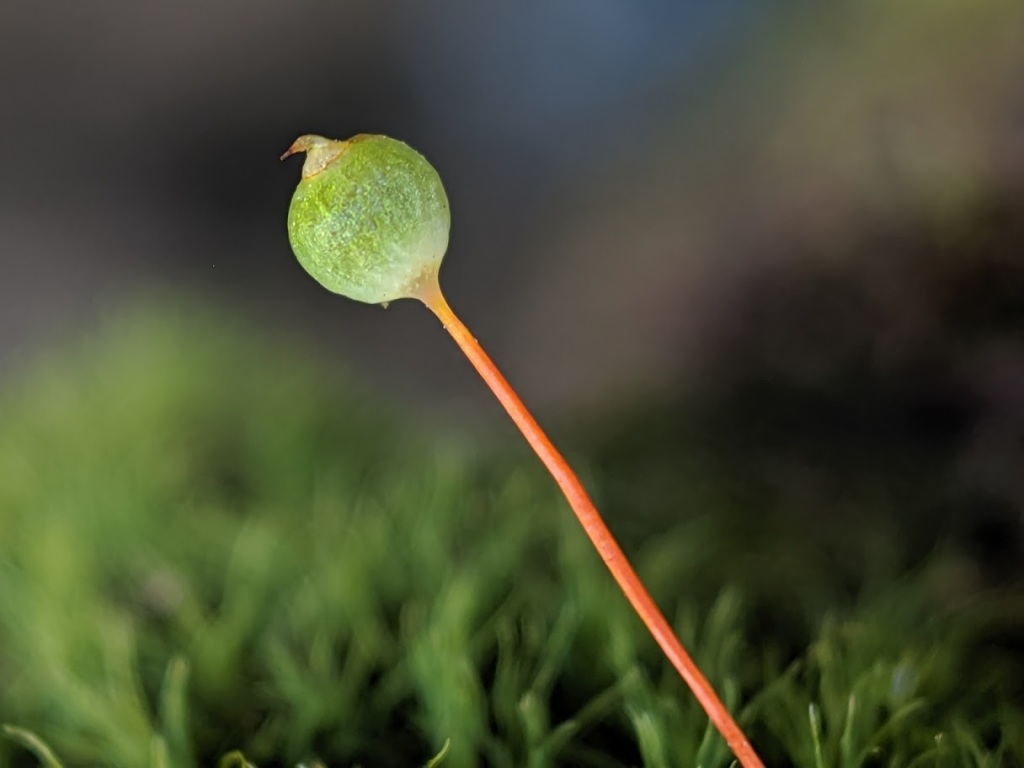Bartramia
Dioicous, autoicous, paroicous (not in Victoria) or synoicous. Asexual reproduction rarely by caducous leaves (not in Victoria). Tufts or cushions on soil or rocks. Stems erect, simple, sparingly branched near base or rarely with innovations below sporophytes, tomentose or rhizoids sparse at base. Leaves narrowly- to linear-lanceolate, erect to wide-spreading when moist, straight and appressed, slightly twisted around stem, or spreading and curled or twisted when dry, not in distinct ranks, not plicate, with or without a differentiated sheathing base and abruptly or gradually narrowing from base; apex acuminate or subulate; costa subpercurrent to excurrent; margin serrate or serrulate with single or double teeth toward apex, plane or revolute; laminal cells subquadrate to oblong or linear, prorate on both surfaces, becoming smooth and rectangular or linear in sheathing base, sometimes quadrate in basal marginal rows, bi- or tristratose at least at margins, but often throughout; alar cells not differentiated. Capsule erect or inclined, symmetric or asymmetric, globose to broadly ovoid or pyriform, operculate or rarely cleistocarpous (not in Victoria), furrowed, wrinkled (not in Victoria) or smooth when dry, without an annulus. Operculum convex, umbonate or conic. Peristome absent, single or double; exostome teeth when present apically free, cleft apically or entire; endostome when present half to equal exostome length; cilia absent or rudimentary.
Cosmopolitan, with 71 species given in Virtanen (2003), but likely to be far less as worldwide revisions by Fransén (1995; 2004a, b) of two of the Sections, including the most speciose, recognise 25 species; seven species in Victoria.
Bartramia is currently divided into three sections: Bartramia, Vaginella and Strictidium. These sections correspond to lineages detected in phylogenies based on combined nuclear and chloroplast DNA sequences with limited taxon sampling (Damayanti et al. 2012; Câmara et al. 2019). Section Bartramia is characterised by autoicous sexuality and leaves that narrow gradually from base into a unistratose linear limb and are flexuose or curled when dry, and in Victoria is represented by B. mossmaniana Müll.Hal. (Fransén 2004a). Section Vaginella is characterised by dioicous, paroicous or synoicous sexuality and leaves that abruptly narrow from a sheathing base into bi- or tristratose subulate limb and are often straight and appressed to the stem when dry (Fransén 2004a), and in Victoria is represented by B. hampeana Müll.Hal., B. robusta Hook.f. & Wilson and B. subsymmetrica Cardot. Section Strictidium is characterised by dioicous or synoicous sexuality and leaves without a sheathing base that narrows gradually into a bistratose triangular limb and are straight and appressed when dry (Fransén 2004a), and in Victoria is represented by B. breutelii Müll.Hal., B. nothostricta Catches. and B. strictifolia Taylor. It is likely that Leiomela, a pantropical genus of twelve species (Matteri 1997), will need to be subsumed in Bartramia as it appears to be derived from Bartramia section Vaginella (Damayanti et al. 2012). Leiomela is distinguished from Bartramia by its immersed capsules and reticulate spores (Matteri 1997)
 Spinning
SpinningCâmara, P.E.A.S.; Soares, A.E.R.; Henriques, D.K.; Peralta, D.F.; Bordin, J.; Carvalho-Silva, M.; Stech, M. (2019). New insights into the species diversity of Bartramia Hedw. (Bryophytina) in Antarctica. Antarctic Science 31: 208–215.
Damayanti, L.; Muñoz, J.; Wicke, S.; Symmank, L.; Shaw, B.; Frahm, J.-P.; Quandt, D. (2012). Common but new: Bartramia rosamrosiae, a “new” widespread species of apple mosses (Bartramiales, Bryophytina) from the Mediterranean and western North America. Phytotaxa 73: 37–59.
Fransén, S. (1995). A taxonomic revision of Neotropical Bartramia Section Vaginella. Lindbergia 20: 147–179.
Fransén, S. (2004a). A taxonomic revision of Bartramia Hedw. Section Bartramia. Lindbergia 29: 113–122.
Fransén, S. (2004b). A taxonomic revision of extra-Neotropical Bartramia Section Vaginella C.Müll . Lindbergia 29: 73–107.
Matteri, C.M. (1997). Leiomela (Bartramiaceae, Musci), a new genus for Argentina. Journal of the Hattori Botanical Laboratory 83: 251–255.
Virtanen, V. (2003). Phylogeny of the Bartramiaceae (Bryopsida) based on morphology and on rbcL, rps4, and trnL-trnF sequence data. The Bryologist 106: 280–296.



